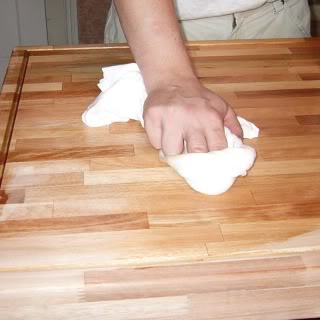Wood Countertop Maintenance Tips

credit: woodzone.com
It may be tempting to treat all wooden countertops just like butcher blocks, but you could end up with an ugly, unhealthy countertop that doesn’t last very long if you cut food and rest pots on a wooden countertop. Some homeowners install butcher block counters so they have an automatic work surface, but using the countertop as a cutting board could invite bacteria and may be more work in the long run.
Here are a few tips for ideal wood countertop maintenance:
Finish With Oil
After installing new wooden countertops, and every two years thereafter, rub mineral oil or tung oil into the surface. Many specialized mineral oils for wooden countertops are available. Make sure the oil is food-safe (but not a cooking oil). Tung oil is a tighter, more water-resistant compound than some alternatives. There are also oils with paraffin wax or beeswax mixed into the compound for greater stain resistance. You can also mix one part food-safe wax with five parts oil. Pour liberal amounts of oil onto the surface and let it soak in for about 30 minutes. Then wipe off the remaining oil and you should have an attractive, durable wooden countertop.
Cut it Out
After the initial oil rubdown, protect your wooden countertops. Don’t cut directly into wooden countertops. They may look just like cutting boards, but the real cutting board is easier to clean and it is meant to have cuts, nicks and dents. Not only will knives cut into a countertop, but they can leave bacteria in the countertop surface.
Don’t Let it Burn
Likewise, the countertop and a wooden trivet may have similar surfaces, but burns on trivets are more expected and easier to manage. Don’t rest hot pots, pans or trays directly on a wooden countertop.
Catch it Quickly
If anything spills on a butcher block counter or other wooden countertop, try to wipe it up quickly. The surface is more impervious than you might think, but stains can certainly soak into the wood.
Sand it Away
A quick and light sanding will typically clear up light scratches, burns or stains on your wooden countertops. Always use the finest grit you can get away with, then follow up with 180-grit finishing sandpaper. Then reapply your tung oil or mineral oil of choice.
Don’t be Tempted to Coat
Finally, if all this wooden countertop maintenance sounds like a lot of work, you may be tempted to just cover the whole surface with a polyurethane coating. We advise against it because scratches or stains will eventually appear on the surface and the coating will need to be stripped and replaced, which ends up being more work than the occasional sanding and oiling.
Author Steve Graham is a former construction manager and newspaper editor. He has written more than 2,000 articles for Web sites, magazines and newspapers.
Looking for a Pro? Call us (866) 441-6648

Carpenters Experiences

Thoroughly Modern Bathroom Remodel

Bathroom Tile With Outstanding Attention To Detail



